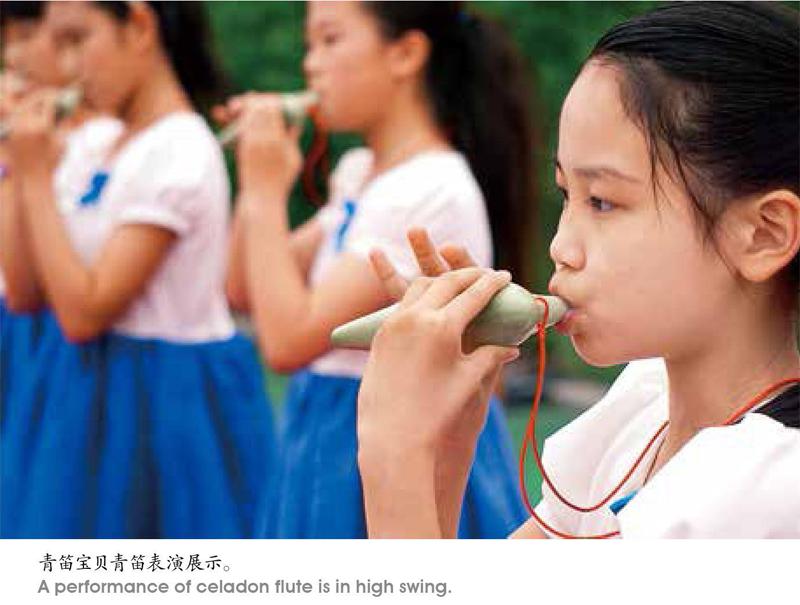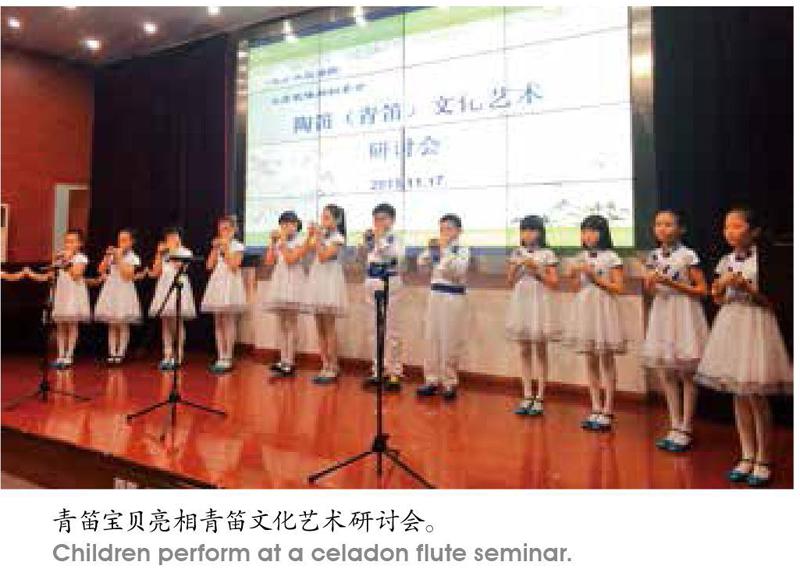青笛悠扬四海情
2018-05-09沈招娣
沈招娣
绍兴上虞堪称世界“青瓷之源”,2000多年前,智慧的古人采撷了这里的泥土,用非凡的创造力烧制出了全世界第一个青瓷器具。曹娥江畔大大小小的山里,至今还有古时留下的青瓷碎片在熠熠发光。青笛是一种由青瓷制成的笛子,它清丽的颜色和青瓷的“天青色”如出一辙。吹着它,所展开的无疑是一幅上虞悠久而清丽的诗画长卷,宛如悠扬的音符会穿越悠长的历史时空。
上虞区盖北镇中心小学把传统文化引进课堂,不光教孩子们学会吹青笛,还教他们用泥巴做青笛,拿纸笔画青笛,让这种适合农村学生、携带方便、经济实惠的器乐类拓展课程,为孩子们编织起能握在手中的音乐梦想,让占学校生源七成的“流动花朵”们把青瓷文化带向五湖四海。
“青笛是由埙变化而来的乐器,它是一种小型的吹奏乐器,比较好拿捏又方便携带,走到哪就可以吹到哪,特别受孩子们的欢迎。”青笛教师陈亚春说。
小青笛传播大文化
2015年5月,偶然的机遇让盖北镇小的孩子邂逅了青笛,孩子们一吹就爱上了它。从当时10多个学生的青笛社团到现在四、五年级学生的普及教育,青笛在盖小的校园稳稳扎根。
“好的课程需要好的教材。早在决定开设青笛拓展课程的时候,我们就着手编写课程纲要、开发校本课程。”校长王光标说。2016年暑假,校本教材《笛韵悠扬》落笔定稿,教材分悠悠青韵(历史文化)、指法练习、舌部技巧、手指技巧、作品欣赏五个板块,将青瓷文化与青笛吹奏技能融入日常教学,实现文化传承与技艺学习的螺旋上升。同时,学生评价手册也运用而生。
“说实话,校本教材的开发,让我和阮佳波老师压力很大。一方面是音乐元素如何表达在纸面上,我们没有相应的操作软件,有想法却表达不出来,并且编教材总给人高大上的感觉,让我感觉底气不足;另一方面,学校要求教材中编入关于青瓷文化发展的历史知识,要查阅、考证这些历史也困难重重。”音乐老师陈亚春如是说,“好在学校给予了很大的支持,我们总算是熬过来了,有了教材,孩子们就能学得更系统。”
学校组建了以分管校长为第一责任人的“青笛拓展课程系统开发”工作小组,在编写教材的同时,还积极探究青笛课程与其他国家课程、活动课程的融合与整合。一方面,在青笛吹奏中尝试融入打击乐器、诗歌、舞蹈等多种元素,丰富学生的角色体验;另一方面,以传承青瓷文化、演绎青笛技能为特质,与语文、美术、综合实践、孝德文化等课程相联结,提升学生各方面素养。
2016年12月,“语文课堂话青瓷、音樂课堂吹青笛、美术课堂画青笛、综合实践课堂做青笛”——创意满满的四节拓展课亮相上虞区第八届课堂教学艺术节暨拓展性课程课堂研讨活动上,好评如潮。正如原上虞区教研室副主任傅智红评价所说,“这样的课堂是成功的课堂,这样的拓展课程让我们喝到了课程改革的第一口水,我们要做上虞母性文化的代言人,让小青笛传播大文化。”
随着课程实施的逐步深入,教学设计、教学课件、教学微课等配套教学资源也一一被开发,课程的系统性、递进性得到了很好的保障。2017年9月,拓展课程《青笛悠扬》被评为绍兴市精品课程,并被推荐参加省精品课程的角逐。“避免因个别教师岗位调整而无法继续实施拓展课程的最好途径,是学校能系统开发课程、保障配套资源的齐备。临时抱佛脚去找资源上拓展课,是一线教师最痛苦的事情,要想课程能深入、有质量地实施,课程的顶层设计非常关键。”学校分管负责人说。
众教师爱上吹青笛
教师走多远,学生才能走多远。盖北镇小把打造品质教师作为学校的核心工作之一,通过专家引领、专业学习等方式,不断优化师资队伍。
在专家层面,学校聘请中国陶笛艺术委员会副会长、浙江省陶笛协会会长顾龙星,中国陶笛艺术委员会副会长、江苏省特级教师蒋显敬为青笛教学项目顾问,并成立盖北镇小顾龙星青笛工作坊,为深化青笛教学提供专业支持和技术保障。
在教师层面,学校组建教师青笛俱乐部,每周开展一次学习活动;组织相关教师赴宁波奉化新城实验小学学习,了解该校接洽专业陶笛培训机构、全校普及陶笛教学的特色做法;组织教师赴江苏省级艺术特色学校、曾经创造过5400名学生同台演奏吉尼斯纪录的江苏丰县创新外国语学校取经,研究拓展性课程的推广、深化。
两年来,该校教师参加了绍兴文理学院“青春·虞你同行”大型文艺晚会、科协送文艺下乡等众多群众性活动,还在首届上虞区校园青笛比赛中荣获教师组二等奖,不少教师已经参与了青笛专业考级。
“我来学青笛,最初是因为我儿子在幼儿园学青笛,想着自己学一点也可以教教儿子。现在,我们家晚上挺热闹的,我和儿子吹青笛,我老公吹口琴,别样的合奏给生活增添了新的乐趣,还蛮好的。”教师青笛俱乐部成员叶华兰老师说。其实,青笛俱乐部不少老师当初都是抱着叶老师这样的想法来的,但真正接触了青笛之后情不自禁地喜欢上了,课间、午间休息的时候吹一吹,也是一种休闲放松。
从校园走向五湖四海
“没学之前感觉青笛很难吹,学了之后发现挺简单的。我学青笛的窍门就是先在训练中打好基础,每天再练习一个小时左右,星期五的时候还会参加学校的社团课。”人称“青笛小王子”的学生万成说,不到1年时间,小家伙就把6级的曲子吹得出神入化,一举荣获浙江省陶笛之星银奖。
没有历练就没有成长。盖北镇小一贯重视学生成长舞台的搭建,两年间为孩子们创设了诸如汤浦第四届童装博览会、盖北镇葡萄孝亲活动、全民大舞台之盖北主场活动、上虞区首届全民终身学习活动周节目录制、我是大明星、乡村流动舞台等众多青笛表演平台,锻炼盖小学子的能力,并在历练中传承和弘扬上虞青瓷文化。
來自台州的三胞胎特别有意思。当时三个娃都兴高采烈地申报了暑期青笛亲子班(学校开设的免费培训班),并且音乐天赋都不错,奈何两个妹妹的手太小巧,老师担心手指捂不住笛孔而没选中。每每哥哥上课,两个陪读的妹妹就偷偷躲在门外听,老师被小姑娘们的好学而感动,破例将她俩选入社团。不负众望,兄妹三人现在都是盖小最优秀的青笛宝贝,哥哥展毅荣获省陶笛之星银奖,两个妹妹是学校老师拍摄青笛微课的御用“模特”。据悉,最会闹腾的老大从学青笛开始已经弄坏了4根青笛,但妈妈郑巧燕还是很支持他学青笛,“孩子们的生活丰富了,还经常参加学校组织的各种校内外的活动,性格更加开朗大方,我们做家长的能不支持吗?”
不仅如此,盖北镇小更是立足校园,面向社会,让本校学子以上虞青瓷文化为荣,让“流动花朵”为上虞青瓷文化代言。“我们学校生源比较特殊,有来自全国24个省市、13个民族的‘流动花朵1625人,寒假我们号召大家在自己的老家,在家乡的景点吹奏青笛,让世界聆听上虞。”校长王光标说。
来自湖南的苗族同学杨书贝在家乡的湿地公园演奏青笛,主动向行人介绍青瓷文化,还让爸爸发送朋友圈推介活动。这些活动,让过去沉默寡言、内敛害羞的小姑娘有了前所未有的自信和骄傲。书贝的爸爸说:“我真是想不到,一支小小的青笛,让我的女儿有了如此大的改变。”
The beauty of Yue celadon left even the most capable poets at their wits end. They compared the color of the celadon with the autumn sky and the emerald transparency with undulating mountains, only to find such depictions still too weak to say anything substantial. The celadon flourished in the ancient Yue territory, which included Zhejiang as the core part, from the Han Dynasty (202BC-263AD) all the way down to the Northern Song Dynasty (960-1127) of China. Many centuries after the heyday of Yue celadon craftsmanship, the elusive beauty of Yue celadon became known by the world as “the secret color”.
In the remnants of celadon kiln sites in the wilderness of the suburbs of Shangyu - the epicenter of Chinese celadon tradition, celadon pieces of all sizes and styles are waiting to be excavated to unveil the mystery of the ‘secret color. It is believed that ancient craftsmen living on the banks of the Caoe River in Shangyu made the worlds first celadon ware about 2,000 years ago. One of their innovations is (meaning ‘celadon flute), a portable wind instrument derived from the (an ancient egg-shaped , holed wind instrument) artistry.
The tradition has come to life at the Gaibei Primary School in Shangyu, where students learn not only how to play the beautiful instrument but also how to make the flutes. With more than 70% of the students falling into the migrant category, the schools musical extracurricular activities are not only sowing the musical seeds in the children but also bringing the magnificent celadon culture of Shangyu to all corners of the country.
The schools flute education started from a ‘ club launched in 2015 and only about 10 students took part in the program at that time. In the summer holiday of 2016, a special school-based textbook was unveiled to formally include playing, together with the countys celadon culture, in the school curriculum.
“Putting together such a textbook was a stressful experience for me and the schools music teacher. At first, we felt clueless about how to present the musical elements in a textbook. To incorporate the historical facts of the Shangyu celadon tradition into the curricular routines was a big challenge too. “Eventually we worked everything out, thanks to the schools support. With such a textbook in hand, children can have something serious to rely on for systematic learning,” said Chen Yachun, the schools music teacher.
The schools education has blossomed into whats been hailed as the ‘Gaibei mode of the ‘curriculum reform of Shangyu. It was rated by the Shaoxing education authorities as a model.
To further improve the quality of its music education, the school spares no effort in optimizing the teaching staff by bringing in an elite expert advisory team and running a celadon flute studio that ensures technical support.
The school also runs various training programs and seminars that are open free to teachers. Many teachers have brought back qualification certificates and medals from city-level contests.
“I joined the schools club just for some basics so that I could teach my son in the first place, but it turned out to become my own hobby that has been adding colors to the family life,” said Ye Hualan.
For Wan Cheng, famed as the ‘ prince of the school, there is no secret to the mastery of the wind instrument. “Learn the basics, and one hours practice every day makes perfect,” said the boy, who took less than a year to take a silver medal home from a provincial-level competition.
“What I want to see is the beautiful melody produced by the cultural pride of Shangyu is shared by more people outside Shangyu and Shaoxing; and with the schools 1,625 students coming from 24 provinces and 13 different ethnicities, I believe we are reaching the goal,” said Wang Guangbiao, the schoolmaster.
